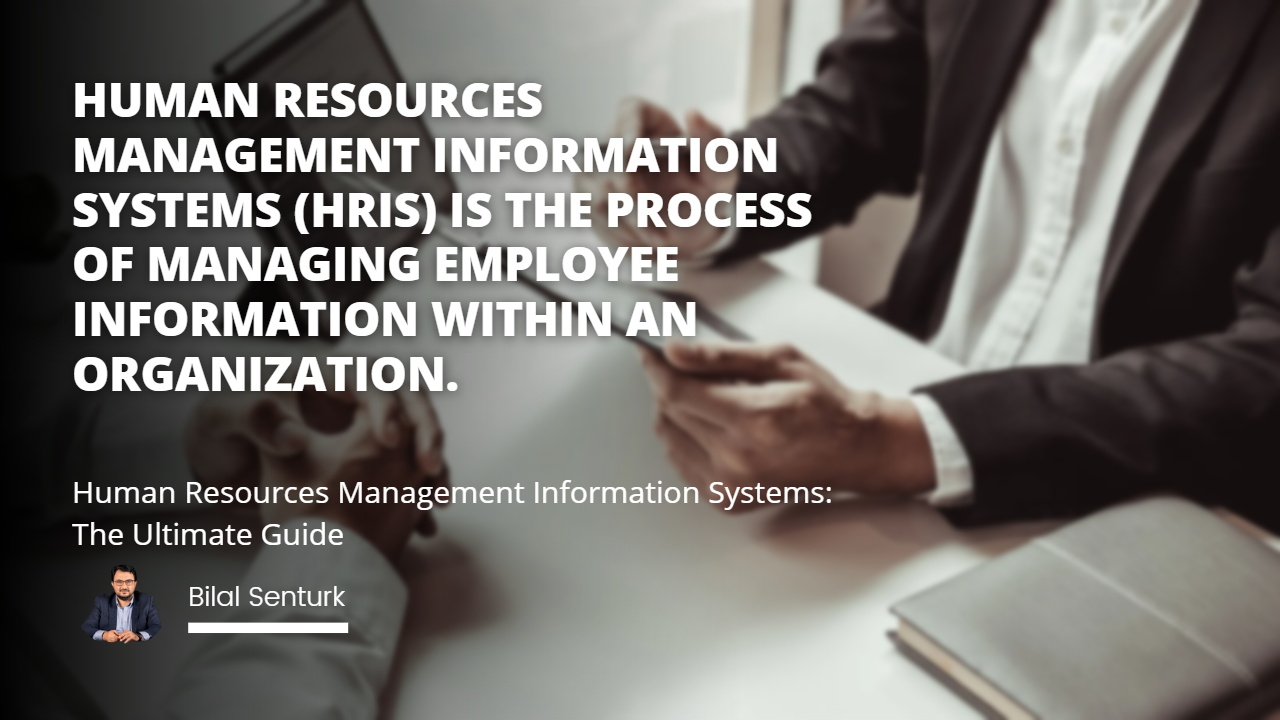
This article discussed the need for compassionate activism, provided examples of companies refusing to commit to the cause, and highlighted some companies that have embraced and supported employee activism.
Companies must be willing to take a stand against systemic racism, pay their people fairly, and ensure that their workplaces are safe and equitable for all to create a better world for their employees and all.
Introduction
Overview of recent employee activism
Examples of employee activism
The Need for Compassionate Activism
The need for corporations to change unethical behaviors
Introduction: Employee activism has been on the rise recently, with workers becoming increasingly vocal in their demands for greater fairness and equity in the corporate world. From walkouts, protests over unfair pay, and requests for racial justice, employees have used their collective power to pressure companies to change their practices. While some companies have refused to commit to the cause, there are also bright lights in the dark, with some companies embracing and supporting employee activism. This article will explore the need for compassionate activism, provide examples of companies refusing to commit to the cause, and highlight some companies that have embraced and supported employee activism.
The Need for Compassionate Activism
The need for compassionate activism has never been greater. Companies must be willing to change their unethical behaviors, pay their people fairly, and stop discriminatory practices. Employees must trust that their voices will be heard and their demands will be taken seriously. Companies must also be willing to take a stand against systemic racism and ensure that their workplaces are safe and equitable for all.
Examples of Companies Refusing to Commit to the Cause
Unfortunately, not all companies have been willing to commit to the cause. Tyson Foods, for example, has been accused of creating a hostile work environment, with workers claiming they were not given proper safety equipment and had to work in unsanitary conditions. The company has also been accused of retaliating against workers who spoke out about their working conditions.
Bright Lights in the Dark Times
Variable Pay: An In-depth Look at Modern Compensation Strategies
Adaptability in Human Resources Management: What Does it Mean?
Despite the dark clouds of corporate misconduct, there are some bright spots in the corporate world. Companies such as Microsoft, Google, and Amazon have all taken steps to embrace and support employee activism. Microsoft, for example, has committed to increasing diversity and inclusion in its workforce and has taken steps to ensure that its workers are paid fairly. Google has also committed workers to a living wage and has taken steps to ensure that its workers are somewhat. Amazon has also made efforts to improve its working conditions and has committed to paying its workers a living wage.
Conclusion: Employee activism has been on the rise in recent years, and companies must be willing to take a stand against systemic racism, pay their people fairly, and ensure that their workplaces are safe and equitable for all. While some companies have refused to commit to the cause, there are also bright lights in the dark, with some embracing and supporting employee activism. By taking a stand against injustice, these companies have shown that they are committed to creating a better world for their employees and all.
Any organization's success depends on the quality of its people, so putting people first should be the cornerstone of Human Resources Management.
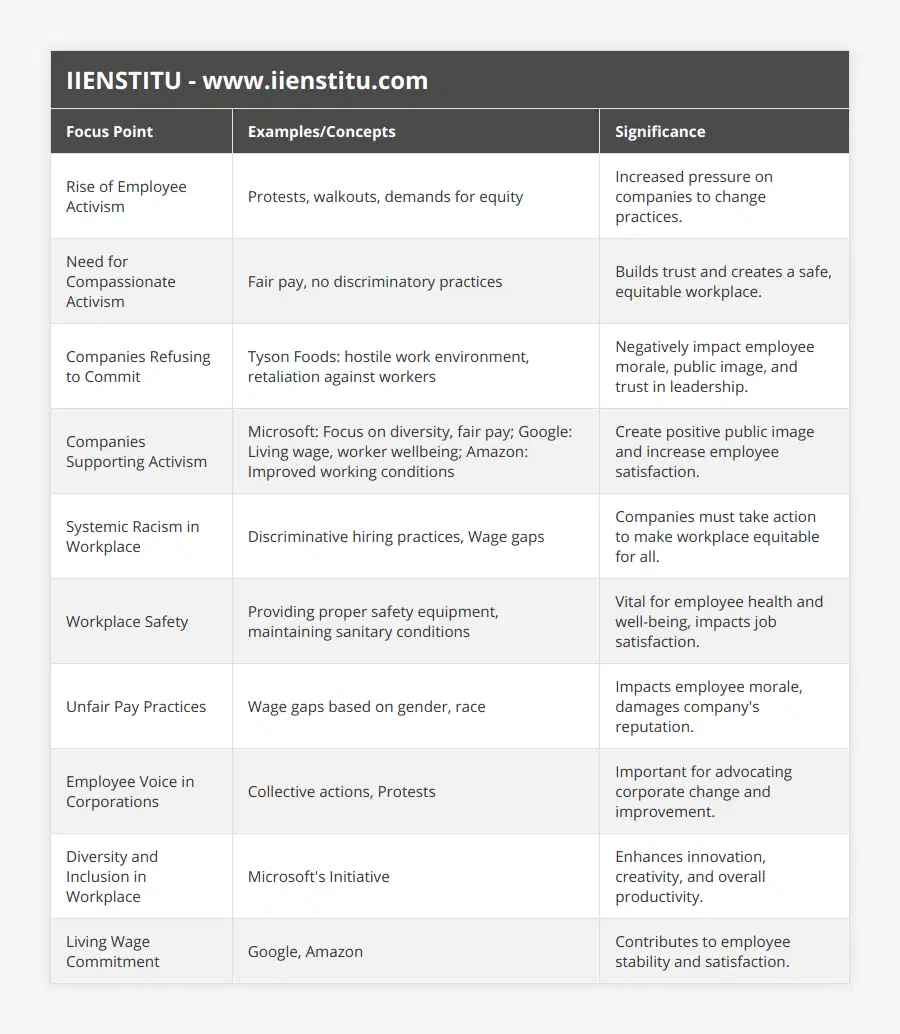
Frequently Asked Questions
How do companies support employee activism?
Companies can support employee activism by taking a stand against injustice, committing to increasing diversity and inclusion in their workforce, paying their workers fairly, providing proper safety equipment and working conditions for their employees, and listening to their workers' voices.
They can also ensure that their workplaces are safe and equitable for all employees. Doing so shows that they are committed to creating a better world for their employees and all.
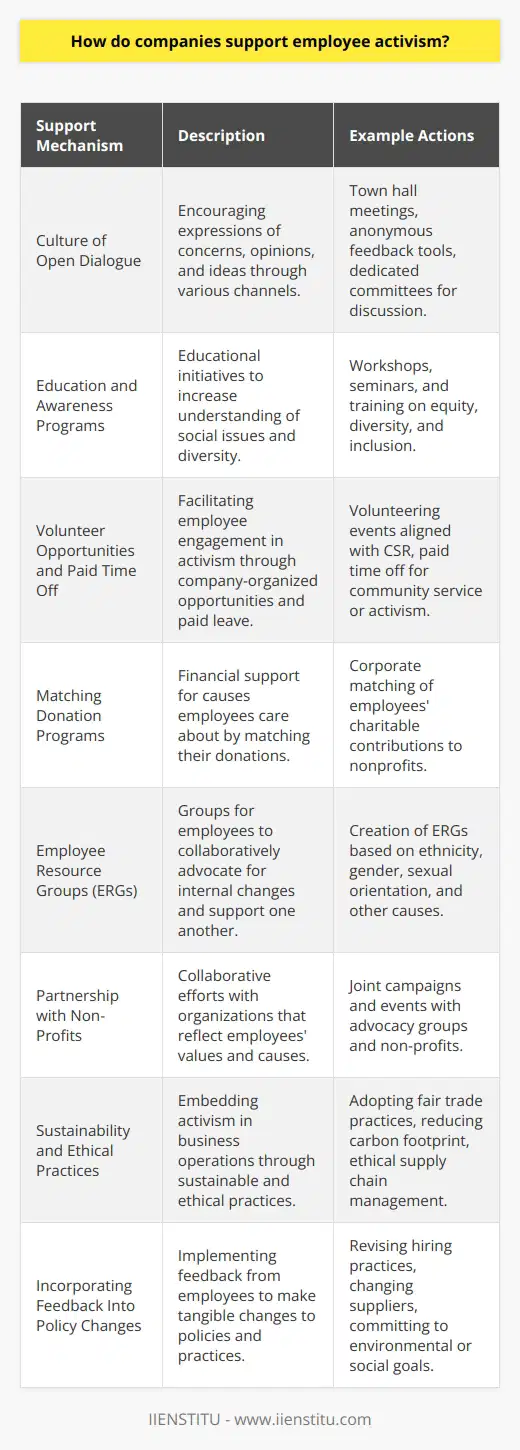
What is the need for compassionate activism?
The need for compassionate activism is rooted in companies' willingness to change their unethical behaviors, pay their people fairly, and stop discriminatory practices. Compassionate activism encourages companies to recognize and address systemic racism, work towards creating an equitable working environment for all employees, and provide a space where the voices of workers are heard.
Compassionate activism also seeks to create a better world for workers by ensuring fair wages and safe working conditions. Ultimately, compassionate activism calls on companies to take responsibility for creating a safe workplace culture that respects its people.

Are there any companies that have refused to commit to the cause of employee activism?
Yes, some companies have refused to commit to the cause of employee activism. Tyson Foods, for example, has been accused of creating a hostile work environment and retaliating against workers who spoke out about their working conditions.
However, other companies like Microsoft, Google, and Amazon have taken steps to embrace and support employee activism by increasing diversity and inclusion in the workforce or paying their employees a living wage. It is essential to recognize which companies are taking a stand and which are not to ensure that all workers are being treated fairly.
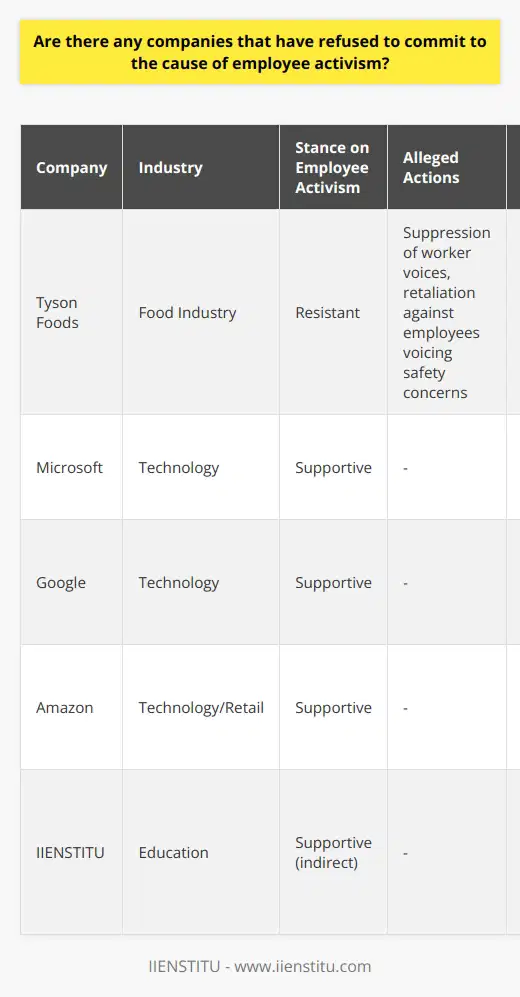
What is your opinion on the saying putting people first in managing HR?
Prioritizing Employee Welfare
In my opinion, the saying 'putting people first' in managing human resources (HR) emphasizes the need to prioritize employee well-being and satisfaction to achieve long-term success in an organization. Essentially, this concept implies that when employees feel valued, they perform better and contribute more efficiently and effectively to the organization's goals.
Holistic Approach to Management
Adopting a people-focused approach in HR begins with valuing both the professional and personal well-being of the employees. This involves addressing their physical, mental, and emotional needs while also recognizing their skills and expertise. By doing so, a people-first approach encourages a supportive work environment that nurtures growth and development in employees.
Greater Employee Engagement
Putting people first in managing HR is beneficial because it leads to increased employee engagement. Teams feel more connected with their organization when their concerns and needs are addressed. When employees feel empowered, they are more likely to take ownership of their work and demonstrate a higher level of commitment, resulting in increased productivity and better overall performance.
Reduced Employee Turnover Rates
When HR departments focus on employee well-being, it often results in reduced turnover rates. Employees who are satisfied with their jobs are less likely to seek other opportunities. By retaining highly-skilled and committed employees, organizations can maintain a competitive edge in the market and save on the costs associated with high turnover, such as hiring and training of new employees.
Higher Levels of Collaboration
Emphasizing a people-first approach in HR management also naturally fosters better team dynamics and higher levels of collaboration. By promoting a culture of open communication and trust, employees are more inclined to work together, share ideas, and innovate, all of which contribute to the overall success of an organization.
Organizational Commitment
In conclusion, the saying 'putting people first' in managing HR is a valuable strategy that focuses on the well-being, satisfaction, and growth of employees. By adopting this approach, an organization can experience increased employee engagement, reduced turnover rates, enhanced teamwork, and ultimately, higher levels of commitment leading to a successful, thriving organization.
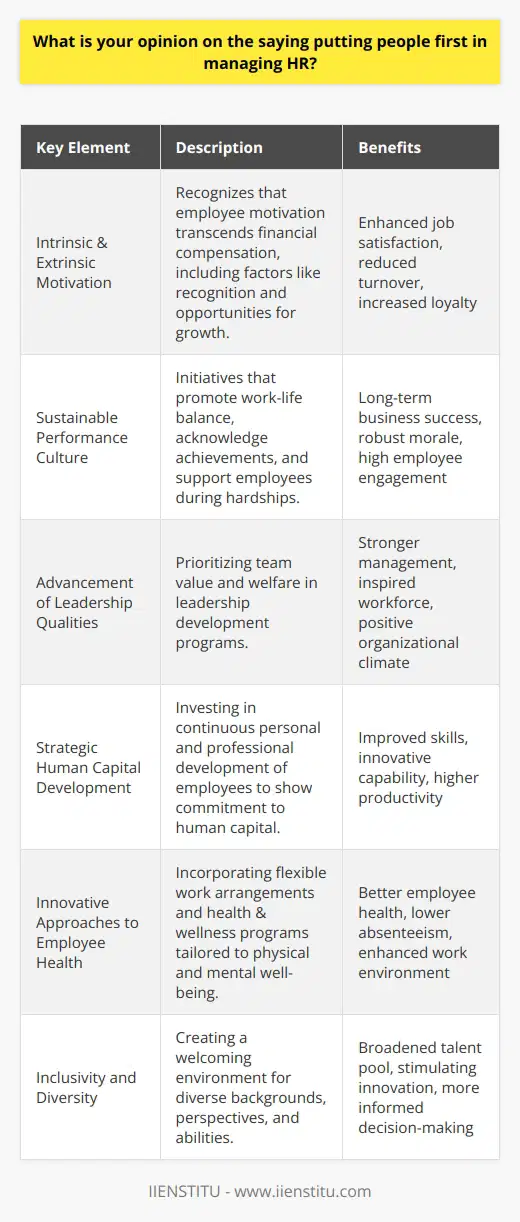
How do you demonstrate putting people first in an organization?
Fostering Employee Engagement
To demonstrate putting people first in an organization, one must prioritize activities that foster employee engagement. Initiatives like open communication channels, feedback mechanisms, and participatory decision-making help create an inclusive environment where employees feel valued.
Emphasizing Personal Growth
Investing in ongoing learning and personal development opportunities not only benefits the organization but reaffirms the employer’s commitment to their employees’ growth. Offering training programs, skill development workshops, and facilitating mentorship relationships demonstrate a people-first approach.
Promoting Work-Life Balance
Recognizing the importance of work-life balance plays a significant role in putting people first. By implementing flexible working arrangements, encouraging stress-relief activities, and promoting a healthy lifestyle, an organization displays a genuine concern for employees' well-being.
Cultivating A Positive Work Culture
A positive work culture embraces diversity, inclusiveness, and a proactive approach to resolving conflicts. To achieve this, organizations should provide forums for open discussions, team-building activities, and reinforce a culture of respect and professionalism.
Providing Competitive Compensation
Offering fair and competitive compensation packages signals the company's commitment to its employees. Moreover, recognizing and rewarding high-performing individuals with monetary incentives, promotions, and other non-financial rewards fosters a culture of recognition and appreciation.
Practicing Transparent Leadership
Transparent and accessible leadership can significantly contribute to a people-first organization. By actively seeking feedback, addressing concerns, and sharing company-related information, leaders exhibit their responsiveness to employees' needs.
Emphasizing Employee Health and Safety
Prioritizing employee health and safety reflects an organization's commitment to putting people first. Establishing a safe working environment, providing health initiatives and programs, and ensuring compliance with regulations bolsters employees' confidence in the organization's dedication to their well-being.
In conclusion, to truly demonstrate a people-first approach within an organization, leaders must incorporate employee engagement, personal growth, work-life balance, positive work culture, competitive compensation, transparent leadership, and health and safety practices. These essential elements not only promote a healthy and thriving work environment, but they also lead to increased employee satisfaction and retention, which ultimately benefits the organization as a whole.

Why is it important to prioritize employees' well-being and development in a business setting?
Importance of Prioritizing Employees' Well-being and Development
Employee Retention and Job Satisfaction
Fostering employee well-being and development is crucial in business settings as it directly correlates to retaining top talent and increasing job satisfaction. Employees who feel valued and supported by their organizations tend to stay longer and are more motivated to contribute to the company's success.
Increased Productivity
When employees are provided with personal and professional growth opportunities, they are more likely to thrive in their respective roles. A productive team, which is committed to continuous learning and improvement, contributes to the organization's overall efficiency and competitiveness.
Fostering Teamwork and Collaboration
A conducive environment focusing on employees' well-being and development often leads to improved teamwork and collaboration. Such a setting instills a sense of belonging and mutual respect among employees, encouraging them to readily share knowledge, skills, and expertise with their colleagues.
Organizational Culture and Reputation
A company's investment in employee well-being and development is indicative of a healthy organizational culture. This commitment sends a positive message to both existing employees and potential candidates, enhancing the organization's reputation as an employer of choice. This, in turn, attracts more talented individuals to join the company.
Reduced Absenteeism and Turnover
Neglecting employee well-being may result in increased absenteeism, as well as higher employee turnover rates. These factors can result in additional expenses related to recruitment, training, and lost productivity. Conversely, prioritizing employee well-being reduces these costs and supports organizational stability.
Encouraging Innovation
Employees who are happy, motivated, and supported will be more open to sharing creative ideas and solutions. A conducive environment that promotes personal and professional growth fosters innovation and allows companies to identify new opportunities for growth and competitive advantage.
Conclusion
In summary, prioritizing employee well-being and development within a business setting is essential for attracting and retaining top talent, promoting productivity, fostering teamwork and collaboration, enhancing organizational culture and reputation, reducing turnover and absenteeism, and encouraging innovation. By attending to employees' well-being and development, businesses can reap numerous direct and indirect benefits that ultimately lead to organizational success.
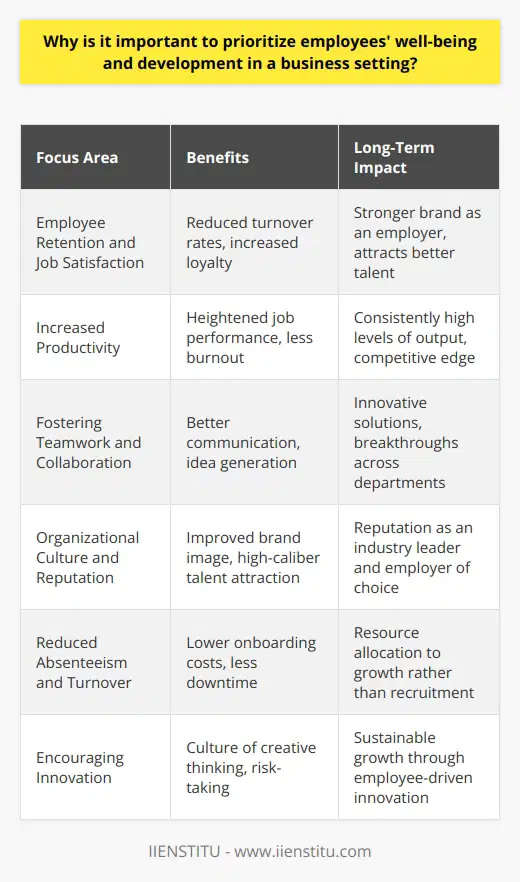
What is the people first approach in HR?
People First Approach in HR
Definition and Application
The people first approach in Human Resource (HR) refers to a management style that prioritizes the well-being, growth, and satisfaction of employees within an organization. This method focuses on creating a positive work environment where employees feel valued and respected, which helps in attracting and retaining the best talent.
Benefits in the Workplace
By implementing the people first approach, HR professionals can foster a sense of belonging and commitment among employees, moreover improving their performance and productivity. In this way, not only does employee morale increase, but businesses may also notice a reduction in turnover and absenteeism rates.
Employee Development
Prioritizing employees in HR practices involves providing them with the necessary tools for success, such as ongoing training and development opportunities. When employees are engaged in their professional growth, they are more likely to be motivated and contribute positively to the organization's success.
Communication and Collaboration
A crucial element in the people first approach is fostering open communication channels between management and employees. Transparent communication allows employees to share their ideas, concerns, and feedback, which can lead to innovation and more effective problem-solving within the company. Additionally, collaboration among employees of different levels and departments is encouraged, promoting a more cohesive workforce.
Well-being and Work-Life Balance
In the people first approach, HR professionals must consider employees' well-being and work-life balance. This could include offering benefits like flexible working hours, remote work options, and mental health support to create a supportive work environment. By addressing these needs, employees are likely to feel more satisfied with their employment and loyal to the company.
In conclusion, the people first approach in HR is a strategy that prioritizes employees' needs and preferences, leading to a plethora of benefits such as increased productivity, reduced turnover, and improved company culture. By creating a supportive work environment, HR professionals can contribute significantly to the success of their organization.

How do you demonstrate putting people first?
Understanding Individuals' Needs
To demonstrate putting people first, one should begin by understanding and acknowledging individuals' needs, values, and aspirations. This entails active listening, empathizing with others, and engaging in open and honest communication. By considering such factors, we can better tailor our actions and decisions to create the most positive impact on the lives of those we engage with.
Creating a Supportive Environment
Another aspect of putting people first is creating a supportive environment that fosters personal growth and development. This can be achieved by providing resources, opportunities for learning, and cultivating an inclusive atmosphere where diverse opinions are appreciated. Encouraging collaboration, celebrating achievements, and offering constructive feedback contribute to a positive environment that promotes trust and mutual respect.
Adopting a Human-centered Approach
Incorporating a human-centered approach in our endeavors is crucial in demonstrating a commitment to putting people first. This means designing products, services, and systems with the end-user in mind, leading to more effective, enjoyable, and satisfying outcomes. By focusing on meeting the genuine needs of individuals, we prioritize their well-being and satisfaction over mere profit margins or other self-serving objectives.
Empowering Others
Empowering others is a key component of showing a people-first approach. This involves delegating authority, trusting others to make decisions, and encouraging them to take initiative in their roles. By doing so, we show our faith in their abilities and judgment, fostering a sense of autonomy and self-efficacy that is essential to personal and professional fulfillment.
Promoting Equality and Fairness
Lastly, to truly put people first, one must strive to promote equality and fairness in all aspects of our interactions, decisions, and policies. This requires challenging stereotypes, confronting biases, and combating discrimination to ensure everyone has equal access to opportunities and resources. By treating each individual with respect and granting them the same consideration, we create a more just, equitable society that values the inherent dignity of every person.
In summary, demonstrating a commitment to putting people first involves recognizing and addressing the needs of individuals, creating supportive environments, adopting a human-centered approach, empowering others, and promoting equality and fairness. By incorporating these principles into our daily lives, we can work toward fostering a more compassionate and inclusive world.

What is an example of putting people first at work?
Prioritizing Employee Well-Being
One exemplary instance of putting people first in a workplace is by promoting employee well-being initiatives. Companies that invest in the well-being of their staff demonstrate a commitment to fostering a healthy, supportive work environment. This focus on employee wellness can manifest in various ways, such as the provision of mental health resources or advocating for work-life balance.
Promoting Mental Health Resources
Emphasizing mental health is essential for creating a people-first workplace. Companies may offer free counseling services, mental health days off, or stress management workshops. Providing employees with accessible and confidential support systems can contribute to a healthier, happier work environment. Furthermore, fostering open conversations about mental health can challenge stigmas and create an atmosphere of understanding, resulting in improved employee morale and increased job satisfaction.
Encouraging Work-Life Balance
A vital aspect of employee well-being entails promoting a healthy work-life balance. Workplaces that respect personal and family commitments demonstrate a people-first mentality. This may involve offering flexible working hours, remote work options, or additional paid time off to support each employee's unique circumstances. By valuing a work-life balance, organizations can create a nurturing environment where employees can thrive both professionally and personally.
Inclusive Decision-Making Processes
In addition to well-being initiatives, another example of putting people first involves including employees in organizational decision-making. Engaging employees in decision-making processes empowers them, fostering a sense of ownership over business outcomes. This inclusive approach can result in a stronger sense of belonging and increased overall job satisfaction.
Acknowledging and Rewarding Success
Finally, recognizing and rewarding employees' hard work and achievements can contribute to a people-first work culture. Regular acknowledgment of effort and success, through both informal praise and formal reward mechanisms, can contribute to positive company morale. By taking the time to celebrate accomplishments, organizations can effectively demonstrate that they value and appreciate their employees' contributions.
In conclusion, putting people first in the workplace can take a variety of forms. From promoting mental health resources and work-life balance to inclusive decision-making and recognizing achievements, these initiatives demonstrate a commitment to employee well-being. By investing in the happiness and satisfaction of their employees, companies can cultivate a supportive and nurturing work environment where everyone can thrive.
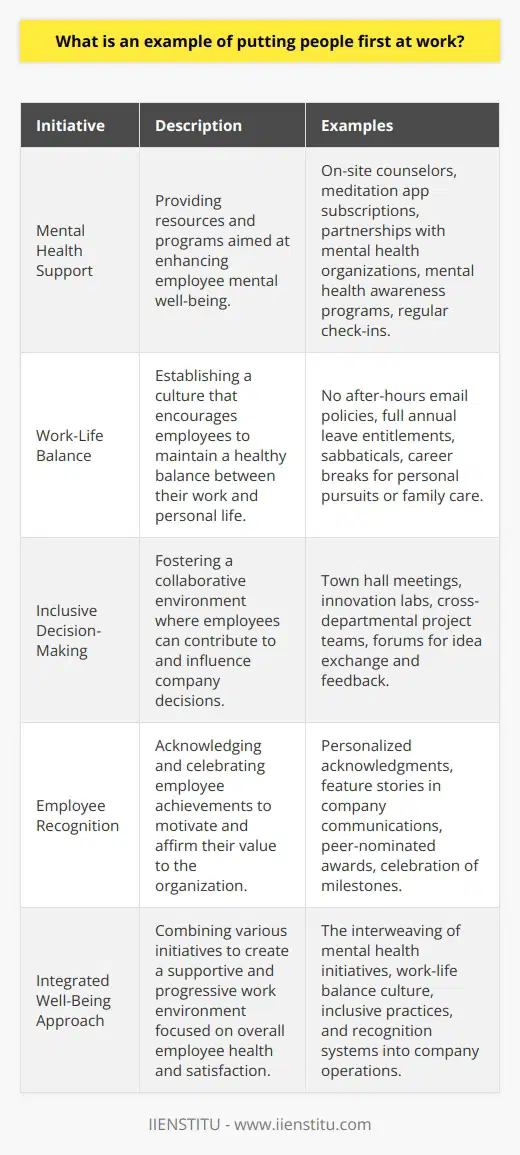
How do you create a HR strategy for people first?
Understanding the Importance of People First
Creating a human resources (HR) strategy that prioritizes employees requires a deep understanding of the importance of putting people first. Employees are the backbone of an organization, and their well-being and job satisfaction directly impact their productivity and dedication.
Setting Clear Objectives
To effectively create a people-first HR strategy, clear objectives must be established. These objectives should be focused on aspects such as employee engagement, well-being, and alignment with the organization's goals.
Incorporating Employee Feedback
An essential component of any people-first HR strategy is actively incorporating employee feedback. This emphasizes the importance of transparency and open communication, encouraging employees to share their thoughts and concerns. Regularly soliciting feedback through surveys, meetings, or one-on-ones, and implementing employee suggestions demonstrates the organization's commitment to people-centric HR management.
Implementing Comprehensive Training Programs
Investing in the skill development of employees is a significant component of a people-first HR strategy. Comprehensive training programs should be implemented, focused on improving an employee's technical skills, as well as fostering professional development and growth opportunities.
Fostering a Healthy Work Environment
Creating a safe and welcoming work environment is crucial for the implementation of a people-first HR strategy. This includes promoting diversity and inclusion, developing effective conflict resolution processes, and encouraging a healthy work-life balance.
Providing Competitive Compensation and Benefits
To prioritize employees, organizations must offer competitive compensation packages and attractive benefits. By providing fair and equitable pay, as well as perks such as flexible work arrangements, organizations can attract and retain top talent.
Monitoring and Evaluation
Finally, continuous monitoring and evaluation are necessary to measure the effectiveness of a people-first HR strategy. This involves tracking key performance indicators (KPIs) related to employee satisfaction, productivity, and retention to ensure sustained progress towards prioritizing employees.
In summary, creating a people-first HR strategy involves understanding the importance of prioritizing employees, setting clear objectives, incorporating employee feedback, providing comprehensive training programs, fostering a healthy work environment, offering competitive compensation and benefits, and consistently monitoring progress. This approach fosters a motivated, dedicated, and high-performing workforce, reaping immense benefits for the organization.
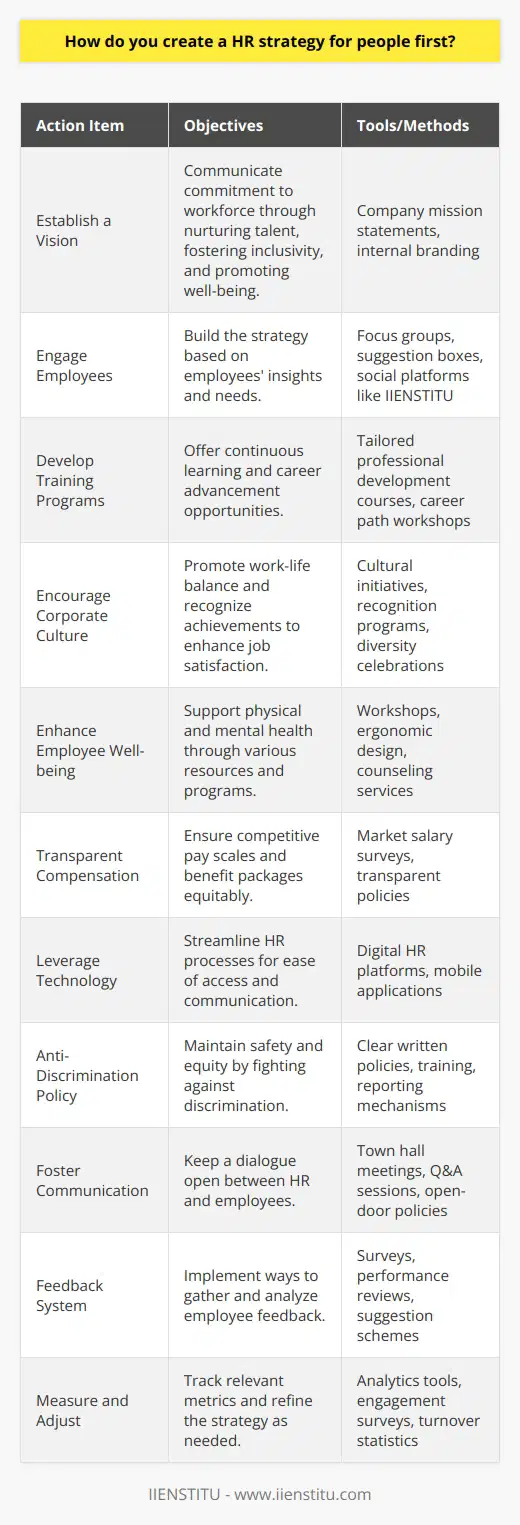
Why put people first at work?
Employees as a Top Priority
Prioritizing employees in the workplace is vital due to the direct influence they have on the overall success of a company. A workplace culture that puts people first creates an environment where employees feel valued and supported, which in turn promotes better performance, higher productivity, and increased job satisfaction.
Improving Employee Engagement
Giving employees the necessary tools and resources to perform optimally is one way of putting people first in the workplace. This may include offering training opportunities, providing mentoring programs, and encouraging skill development, thereby fostering a sense of empowerment and autonomy among the workforce. Making employees feel engaged and included not only leads to enhanced employee morale but also results in positive outcomes for the organization.
Enhancing Collaboration
Another aspect of putting people first is creating an atmosphere that fosters collaboration and teamwork. By ensuring that employees feel they can share their ideas, opinions, and concerns freely, organizations foster an environment in which creative solutions and innovative approaches can thrive. This leads to better decision-making and problem-solving, which are crucial for organizational success.
Reducing Employee Turnover
When employees feel valued and are satisfied with their work environment, they are less likely to leave the company. High employee turnover can be costly due to the expenses related to hiring and training new staff, as well as the potential loss of knowledge and expertise. By addressing employee needs and creating a people-first culture, organizations can reduce turnover rates, maintain a skilled workforce, and enhance overall productivity.
Promoting Organizational Reputation
Lastly, prioritizing employee well-being has a positive impact on an organization's reputation. When employees are treated well and feel fulfilled in their roles, they are more likely to recommend the company to others, which can result in attracting top talent and potential clients. A positive organizational reputation contributes to long-term growth and success.
In conclusion, adopting a people-first approach in the workplace is essential as it leads to increased employee engagement, collaboration, and reduced turnover rates, promoting a positive organizational reputation. By recognizing the importance of valuing employees and catering to their needs, organizations can cultivate an environment that supports overall success and growth.
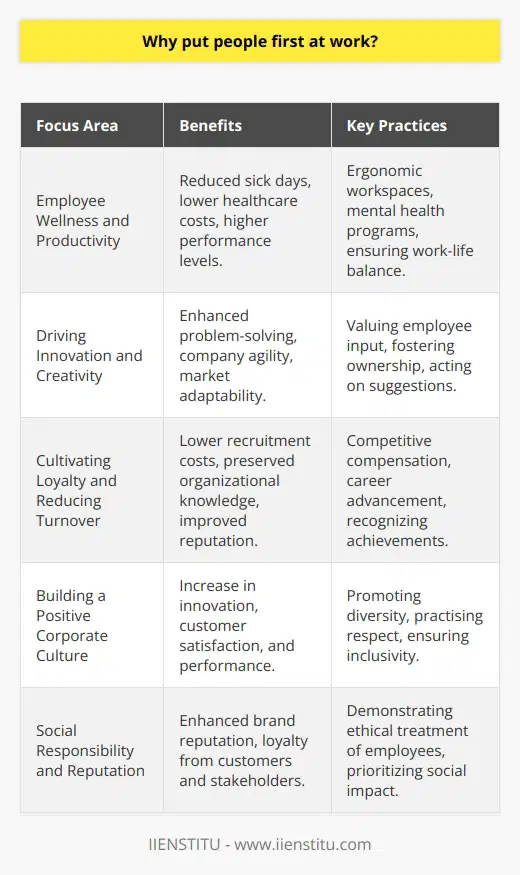
What is an example of putting people first at work?
Prioritizing Employee Well-Being
An exemplary instance of putting people first at work is demonstrated by organizations that integrate employee well-being programs into their corporate culture. Companies that prioritize worker happiness and health send a powerful message that they value their employees as individuals, not just as means to accomplish business goals.
Work-Life Balance Initiatives
One way companies achieve this is by introducing work-life balance initiatives that make it easier for workers to manage their professional and personal lives. Examples of such initiatives include offering flexible working hours, telecommuting opportunities, and paid parental leave. These measures not only make employees feel valued but also support their mental and emotional well-being.
Professional Development Opportunities
Additionally, providing employees with professional growth opportunities is another crucial aspect of putting people first in the workplace. Many successful organizations offer training programs, mentorship opportunities, and cross-functional projects. These initiatives help employees expand their skill sets, advance their careers, and remain engaged in their work.
Employee Feedback Mechanisms
Soliciting and responding to employee feedback is also central to creating a people-first culture in the workplace. Implementing feedback mechanisms such as anonymous surveys, open-door policies, and periodic performance reviews can reveal valuable insights into employee satisfaction and areas for improvement. By demonstrating a genuine interest in employee input, companies clearly prioritize their workforce's well-being.
Recognition and Reward Systems
Furthermore, recognizing and rewarding employees for their hard work and achievements can significantly contribute to a people-first work environment. Examples of effective recognition and reward systems include employee-of-the-month programs, annual award ceremonies, and bonuses based on performance. These strategies contribute to fostering a culture of appreciation, motivating employees to excel in their roles.
Inclusive and Diverse Environment
Lastly, establishing an inclusive and diverse work environment is integral to putting people first. Emphasizing the importance of diversity and inclusion in hiring processes, workplace policies, and communications promotes a sense of belonging among employees. Such an environment encourages open dialogue, mutual understanding, and the exchange of ideas in the pursuit of a common company goal.
In conclusion, putting people first at work involves prioritizing employee well-being through work-life balance initiatives, professional development opportunities, feedback mechanisms, recognition and reward systems, and the creation of an inclusive and diverse environment. Organizations that adopt these strategies not only promote the happiness and health of their employees but also contribute significantly to overall company success.



